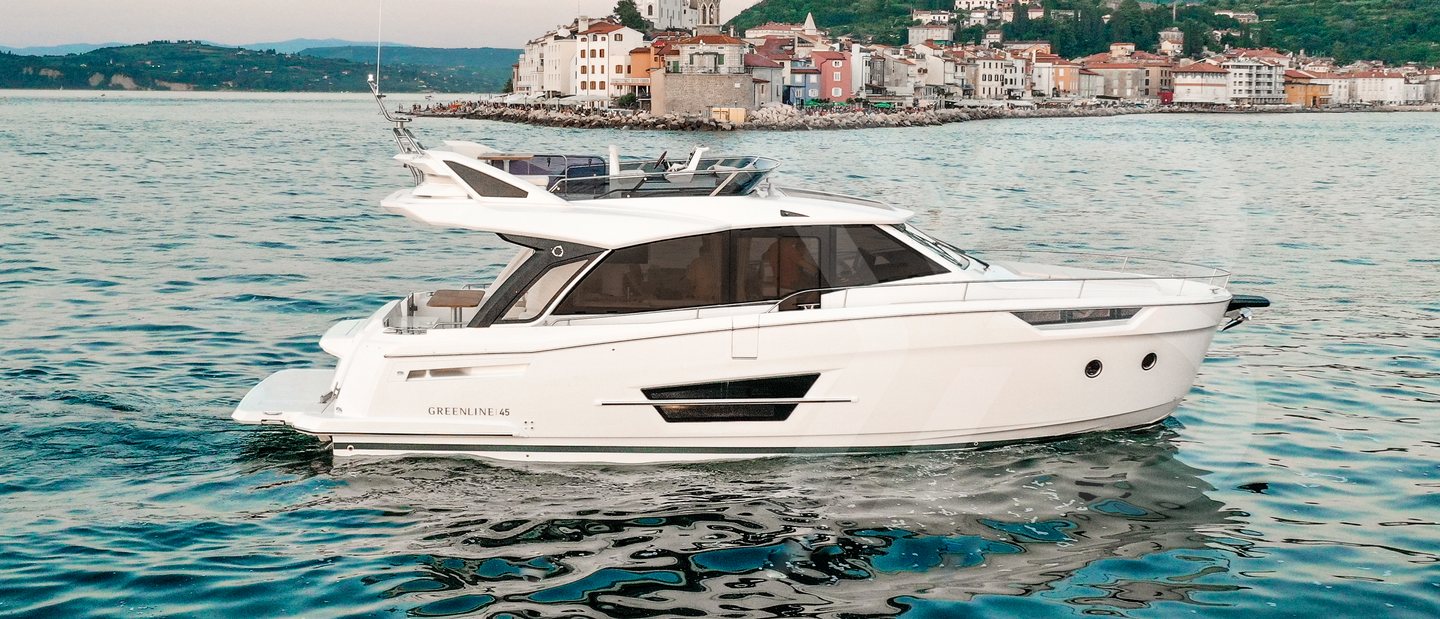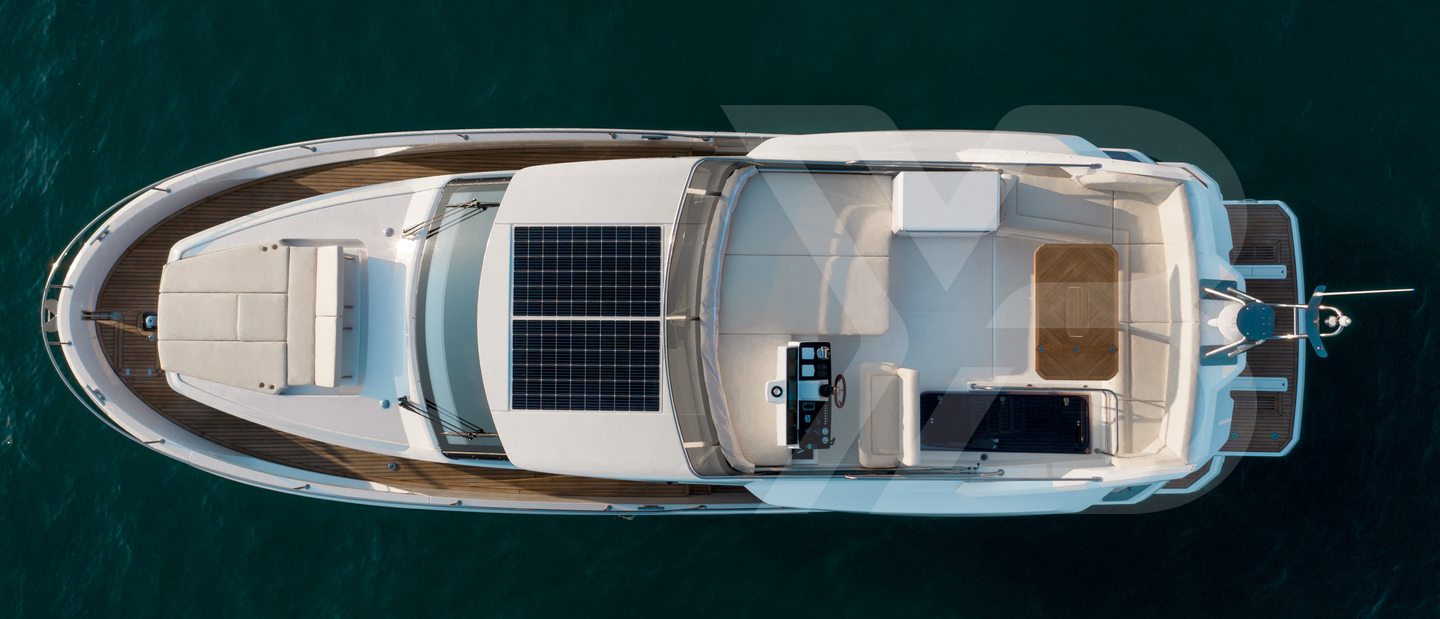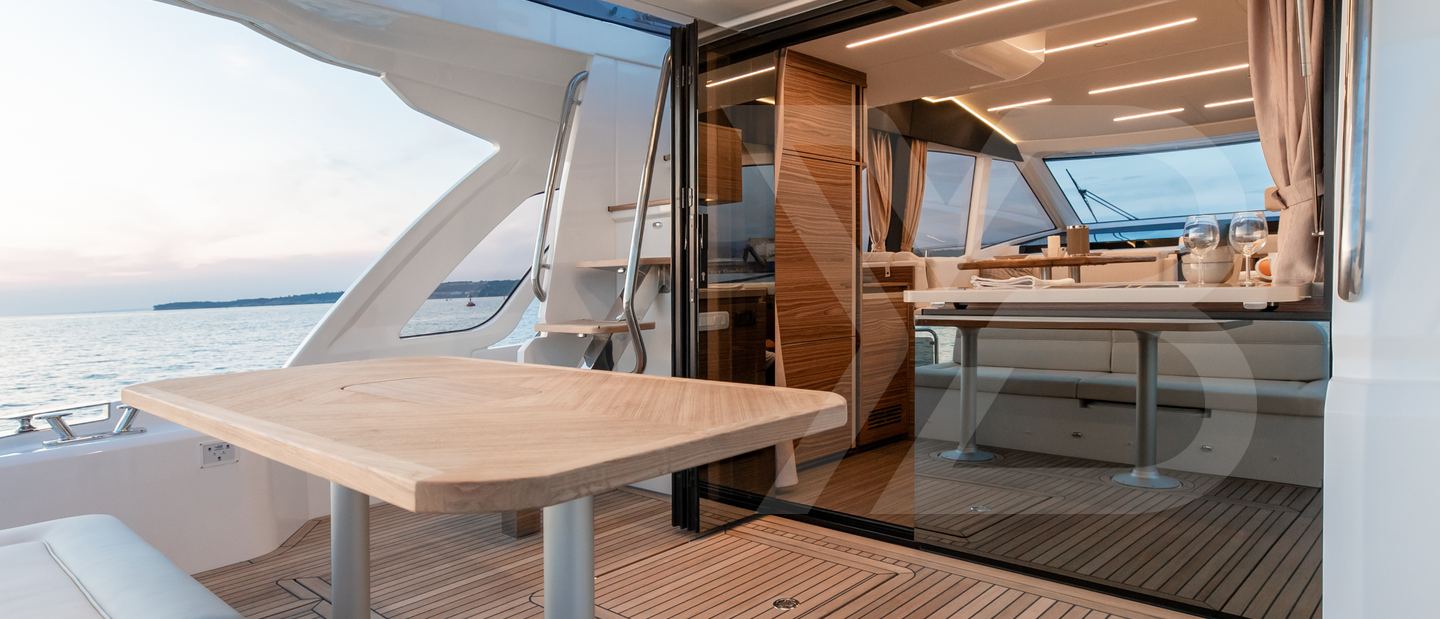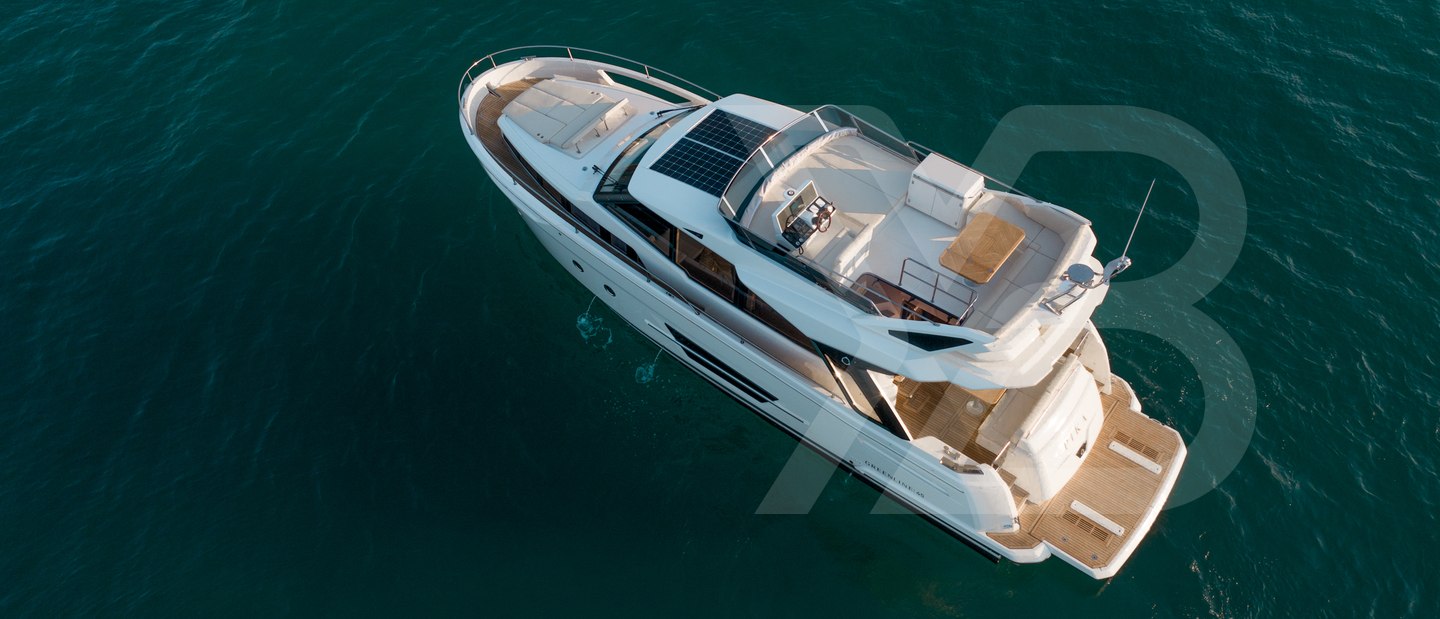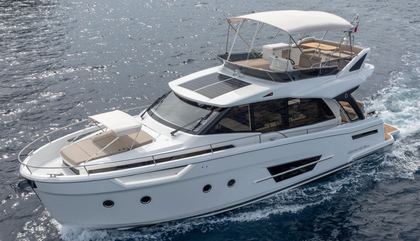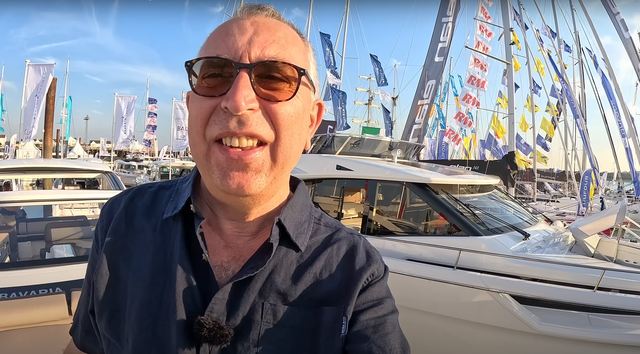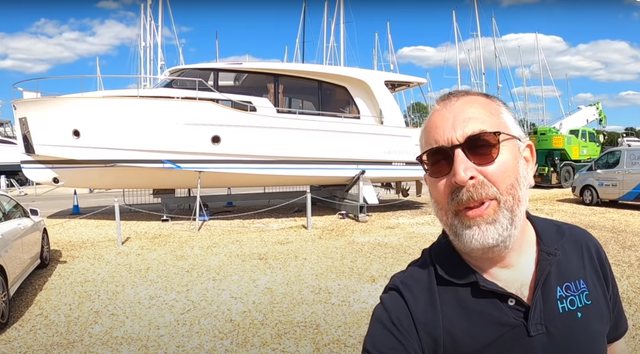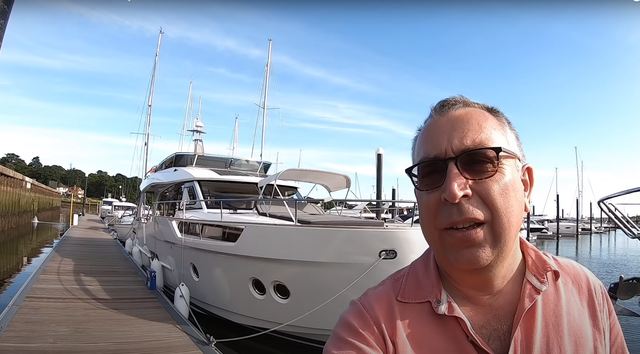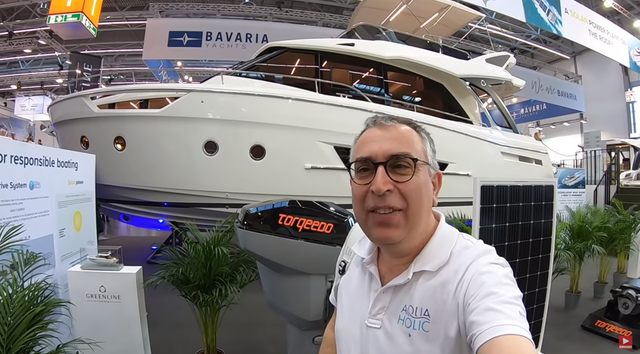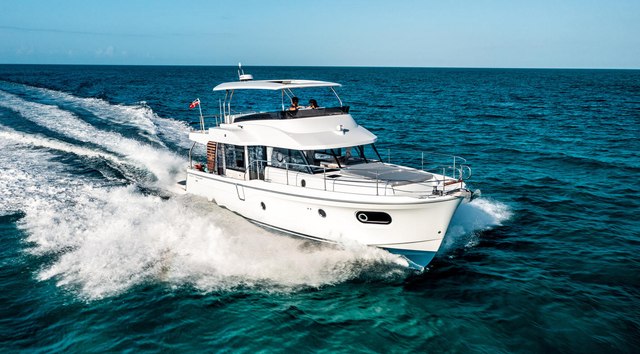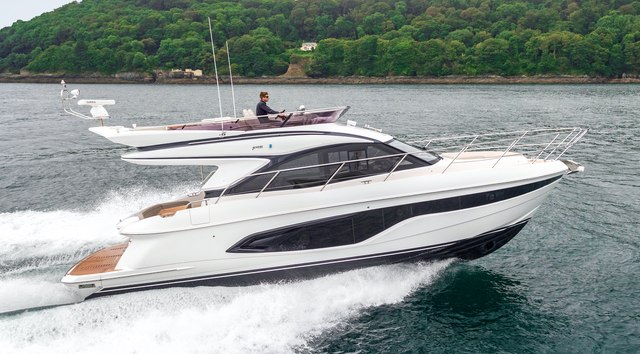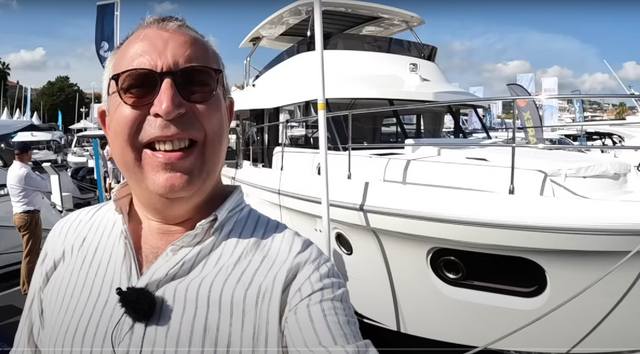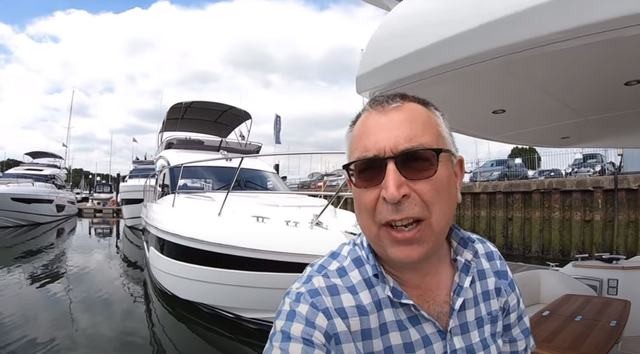The 45 Fly is a victim of unfortunate timing. It debuted at the 2019 Miami Boat Show, had just showed at Boot Düsseldorf 2020 and just as it was getting into its stride the world closed down, so maybe it didn't get the attention it deserved.
There's a lot to digest here. The boat is available with all-electric or hybrid drivetrains and with twin diesel engines on shafts or pod drives. The hull is designed by the reputable team at J&J Design and the interior, in a first for Greenline, by Italian superyacht designer Marco Casali. Our test focused on a version with twin 370hp Yanmar V8 diesels on shaft drives but we did also get the opportunity to drive a 45 with Greenline's latest prototype hybrid drive system.
Test & Review Video
Around the Marina
The slow-speed driving experience is going to be remarkably different depending on what exact version you've chosen. The shaft drive one will be a different proposition to the IPS one when you approach a berth and the hybrid one, which can do all the maneuvering in silence, is something unique in the sector. More on that later.
Our test boat kept it simple — a pair of Yanmar V8 370hp diesels on straight shafts. On a breezy day, the meaty Yanmars could easily flick the 45 into position around a tight marina, the odd burst of the powerful Sleipner bow thruster keeping things in check. A stern thruster is an option and you may want it for extra piece of mind or if this is a step to a bigger or first twin-engine boat but an experienced hand will be fine without it.
Handling the boat from the crew's perspective is pretty easy. It's a safe boat to move around on and the protected side decks mean you don't feel especially exposed when hanging fenders and moving lines around the boat. The helm side door and boarding gate amidships on the starboard side work wonders when it comes to involving the skipper in crew duties. If you're handling the boat alone, it makes it so much easier to get to the quayside than having to disembark from the bathing platform. Some of this boat's rivals have side doors but few have adjacent boarding gates and this makes all the difference.
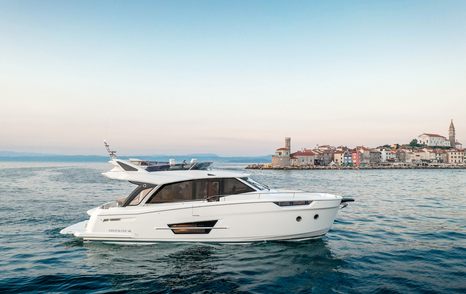
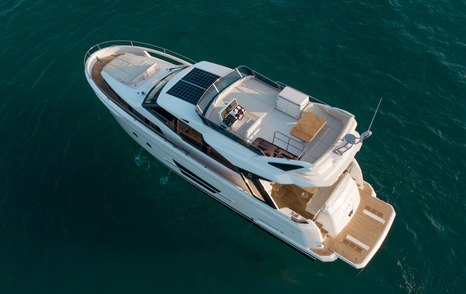
At Sea
We had good test conditions for the sea trial with a stiff breeze whipping up a chop that kicked awkwardly over an underlying swell. It doesn't take long on a planing boat in conditions like this to decipher whether the hull is up to the job but J&J has done a superb job with this one. The 45 Fly rides confidently over the crests, pushing spray well clear of the decks and comfortably romping over the worst of the chop.
The hydraulic steering is stiff and not particularly engaging but the upshot is a very well-planted feeling boat that sits straight as an arrow at speed and isn't knocked about by the incoming waves. The IPS version would no doubt have more feel and suit those who want to drive the boat through the conditions but the hull is so competent it's perfectly comfortable to set the speed and let it do the work.
It's a well-balanced boat, too, albeit we had a very light cruising load for this test. It doesn't take much trim tab to land on a nicely trimmed running attitude where the hull is slicing neatly through the water and not sending unwanted shudders and rattles back into the cabin. It's quiet, too, and no doubt the IPS version would be even more hushed.
The 370hp Yanmars suit the boat well and will push the 45 Fly to 24 knots flat out. You could opt for the 440hp motors but the 45 isn't really about top-end speed. Its 21-knot cruising pace feels comfortable and it will deliver a 250nm range at this speed with 10% reserve in 1,500-litre fuel tanks.
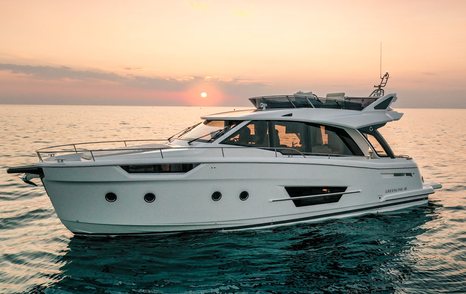

The Hybrid Touch
As part of our test, we were allowed to drive a prototype hybrid version of the 45. It had the same 370hp Yanmars as our main test boat but the in-line hybrid drive adds a pair of 25kW electric motors and a 40kWh battery bank with the option to upgrade to 80kWh. The top speed is 6.5 knots and, with the smaller battery pack, it will cruise for 30nm at 5 knots. Not staggering electric range but Greenline admits the idea isn't for people to travel for miles and miles at a sub-6 knot cruising speed.
The idea is to use the electric motors at slow speed, so you can move around the marina and do slow-speed work in silence and then fire up the diesels when you want to get a move on for the bulk of the journey. There's something to be said for doing the berthing in electric mode, the lack of a diesel rumble just makes the whole process seem more relaxed and the crew don't have to raise their voices to communicate with each other.
In the boating areas I'm most familiar with such as the Solent and Poole Harbour, the ability to cruise silently inside speed-controlled zones or on approach to marinas is an attractive proposition, with the diesels there to take on the bulk of the cruise at higher speeds.
The controls aren't complicated either. The electric motors are linked to the same throttles as the diesel engines so it's just a case of coming to neutral and manually switching between the two. You can even run with one side running the diesel engine and the other on the electric motor. Is it worth the GBP £160,000 upgrade? As you'll read in the sections below, there is more to the hybrid system than silent cruising.
The 45 Fly was designed by Greenline in conjunction with J&J Design, responsible for naval architecture, and Marco Casali, an Italian designer with a background in superyacht interiors. J&J has designed hulls for some of the biggest manufacturers in the game and, having tested a few boats with its hull designs, I can confirm that they know what it takes to make a boat perform well out at sea.
The 45 Fly is unusual in that it was designed to run both shaft drives and IPS and the yard even went to the lengths of designing an entirely new hull for the pod drive version. If performance is a high priority then the 30-knot IPS600 version is the option to go for and it has the added benefit of joystick control at slow speed, which its shaft drive counterparts don't offer in this instance.
Chasing performance on a Greenline is a bit like chasing fuel economy in a Lamborghini, however, so the mid-range shaft drive options feel as though they make the most sense. You can't have the hybrid system with IPS either, though you do still get the solar panels.
There is an all-electric version of the 45 Fly, which has an 80kW/h battery bank and two 100kW motors and will do a top speed of 13 knots and up to 30nm at 7 knots on pure electric. It also has a 25kW diesel generator, which acts as a range extender and gives the boat a 400nm range at 5 knots. It's a niche option but it's pretty unique to have a regular-looking 45ft flybridge that can be propelled on electric power alone.



Eye for Design
Design is subjective, of course, but to my eye, the 45 Fly is one of the best-looking boats in the sector. It's not easy to build a 45ft flybridge boat with three cabins and standing headroom in the amidships cabin and avoid the boat looking top heavy. The 45 has no such issues and has a nice mix of sweeping lines, a purposeful upright bow, and some traditional touches such as the round ports dotted on either side. It's a really sweet-looking boat, especially without the hard top.
Build quality isn't up there with the very best in the sector but it's about on par with the Prestige 450 or Bavaria 420 Virtess (which also has an interior by Marco Casali). There is more attention to perceived quality than on smaller boats in the range, especially inside where no doubt Mr Casali has fought hard to ensure the interior feels suitably upmarket. There are subtle things, too, like the classy hinges on the interior doors and the addition of anti-rattle pads to ensure doors don't bang when the boat is underway. It feels like a good step forward for Greenline.
The interior of the 45 Fly is a case of Greenline, but not as you know it. There are familiar additions like the aft galley arrangement and top-hinged window that opens the area up to the cockpit seating but the look and feel is very different to the smaller models in the range. That's mainly down to the influence of interior designer Marco Casali, who has given this Slovenian boat a touch of Italian flair and a more luxurious look and feel than we're used to aboard a Greenline. There are three wood choices (walnut, teak, and silver oak), lashings of leather detailing, and as standard, a natural wood table that looks absolutely lovely.
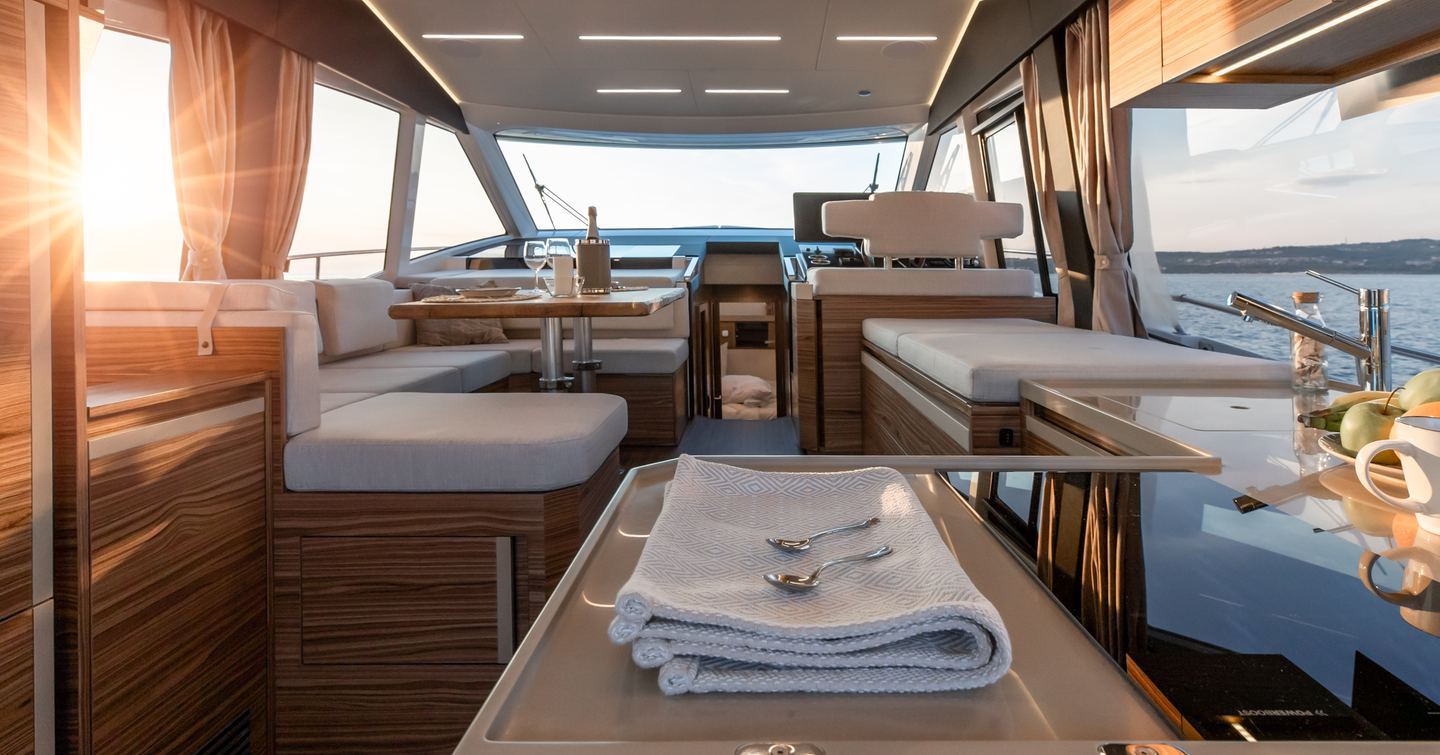
It may have a bit of Italian gloss but this is a Greenline so, of course, functionality is still at this boat's core. The galley is well shaped and has a thick fiddled edge around the counter with a good amount of storage and a useful pair of sockets to plug in a coffee machine or kettle. The appliances are worth a mention here because the solar panels and boosted battery bank mean the 45 can run some heavy-duty kitchenware. It has a proper oven, not just a microwave, induction cooking, and a full-size fridge/freezer that can constantly run without the need to be plugged into shore power.
The dinette forward to port is large and converts into a genuinely spacious and usable extra double berth to supplement the six berths on the lower deck. To starboard, there is a large unit that stores the television, though it's attached to the inside of the lid so gobbles up an inordinate amount of room. On early units, this area had cushions on top to create an extra perch for guests but this has been removed so it feels like a more slimline solution to stow the TV would be a worthy update. There is the option to have a small sofa here instead which, if you're not fussed about having a TV on board, could be a better arrangement.


The Choice Is Yours
One of the most appealing aspects of the 45 Fly is how much flexibility there is for a mid-sector production flybridge boat. I've mentioned the flexibility of the propulsion and drive systems but there is also plenty of play within the physical layout of the boat's lower deck. As standard, there is a two-cabin layout where both cabins get ensuite bathrooms and generous walk-in wardrobes, an unexpectedly luxurious touch for a boat of this size and style.
Alternatively, the walk-in wardrobes can be replaced with a third cabin, with bed options including a single berth, bunks, or a small double. Our test boat had the latter and it's a nice arrangement, though clambering in and out of bed won't be easy because the bed is hemmed on by the cabin sides. If this cabin is mainly going to be used for kids to sleep in then the bunks are probably a better bet and they deliver a little more floor space, too.
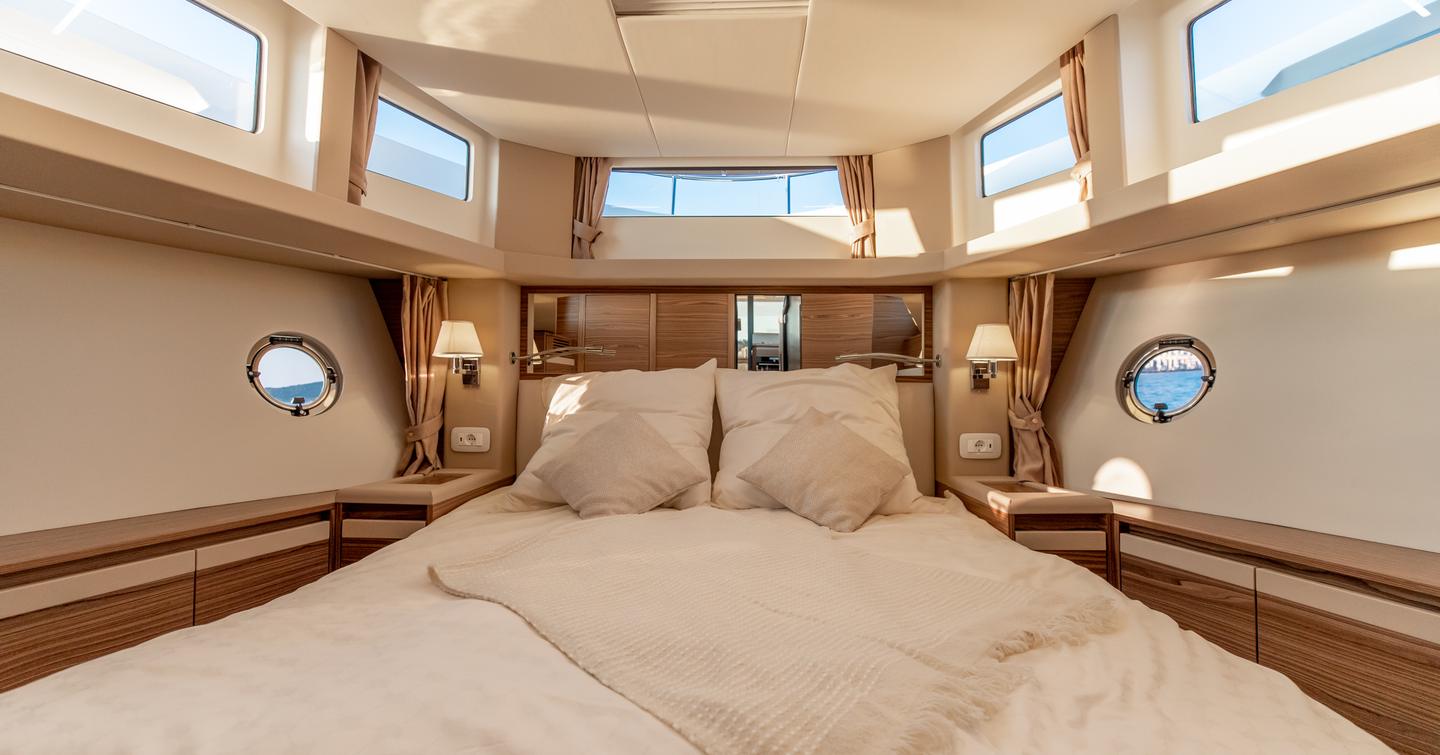
The VIP cabin, forward, is a real treat thanks to the incredible amount of natural light that pours into the space. Eye-level windows dot the perimeter of the coach roof and align with cutouts in the gunwales to deliver clear views out over the water. The levels of light combined with the sheer amount of headroom produce one of the most spacious feeling cabins in the class. The queen-sized double bed is set at a comfortable height and easily accessible from both sides.
Storage solutions are good and include floor and eye-level lockers plus two decent hanging wardrobes for clothes storage. The shallow tray next to the bed on either side is the perfect spot for phones and tablets to be stored safely and within easy reach of plug sockets.
Natural ventilation is good as well, there are large round opening ports on both sides and an opening skylight that brings in yet more natural light and opens for some fresh air.


The Owner's Cabin
The owner's cabin is equally well designed and in a sector where most rivals have headroom restrictions in this cabin the 45 Fly fares well. There is full-standing headroom for someone of 6ft (if not slightly taller) throughout thanks to clever ceiling geometry, which rises as the floor height increases on either side of the king-size bed. In rivals such as the Prestige 460 and even the more expensive Princess F45 and more modern Galeon 440 Fly, you don't have this sort of space to move around unencumbered by ceiling obstructions.
Again, storage is impressive. Low-level cupboards run along the starboard side and a pair of deep hanging lockers in the forward corners of the cabin. A sofa runs down the port side of the cabin, perfect for taking the weight off and admiring the view through the topside hull windows.
The owner's cabin has a private ensuite at the forward end of the cabin but the VIP, though it has private access to the day head, shares it with the guest cabin (if there is one) across the lobby.
Overall, the lower helm is a good design but it's missing some finishing touches here and there that would make it even better. There isn't quite enough adjustment on the seat and steering wheel to get truly comfortable close to the helm and it seems odd to have the switches that you use most at the top of the dash and the screens, which you only need to glance at, lower down. The phone-shaped molding atop the steering wheel housing is crying out to be made into a wireless charger, too, surely the least you can expect these days. Storage is a little lacking, with only a couple of shallow cupholders to stow loose items.
On the plus side, the major controls are well arranged and close to the skipper and the view is excellent. Partly because you have a commanding driving position but also because the boat has such a level running attitude at speed you don't have to crane your neck to see over the bow.
Our test boat only had a single MFD at both helms but there is the option to have two, which I would go for as it gives you much better flexibility with how data is presented. It's good to see a remote panel for the MFD mounted on the lower dash so you don't have to lean forward to use the touchscreen for quick inputs.


The side door makes a massive difference here for both communication and access to the decks. When skippering the boat solo or with one other person, the fact that the person at the helm can go through the door and boarding gate onto the pontoon in seconds makes coming alongside so much easier.
The driving position on the flybridge is better. The bench, though fixed, is much closer to the helm station and there is an adjustable wheel so you can lift it up and away from your knees. The helm is set quite a long way forward and the windscreen is tall so there is a reasonable amount of protection at high speeds. Again, it lacks storage space and the materials look and feel a little cheap but it's functional.
The combination of great sightlines and the side door may mean that the majority of mooring procedures are undertaken from the lower helm but if you do choose to do it from up top you can see the aft end of the platform through the flybridge hatch when coming stern-to and, obviously, the overall view of the boat is great.
There are quite a few options to think about at the aft end of the boat where there's a choice between a hydraulic bathing platform with various weight capacities and the option to have a BBQ on the transom or two different access points to toy storage. Greenline would encourage you to carry a lighter tender, especially if the boat has the hybrid system fitted, but it will fit up to 500kg if you want something heftier on the back.
You can have either a door on the transom that slides up to reveal a storage void or an option where the whole unit lifts to give even greater access. It's not large enough to act as a tender garage but will swallow a whole lot of kit. If you don't opt for either of these (or have the BBQ fitted) access to this storage void is via a hatch in the transom bench. It's not the easiest to get to and this area is about the only place aside from the anchor locker where you can stow fenders on deck. One of the transom storage options would be a sensible addition.
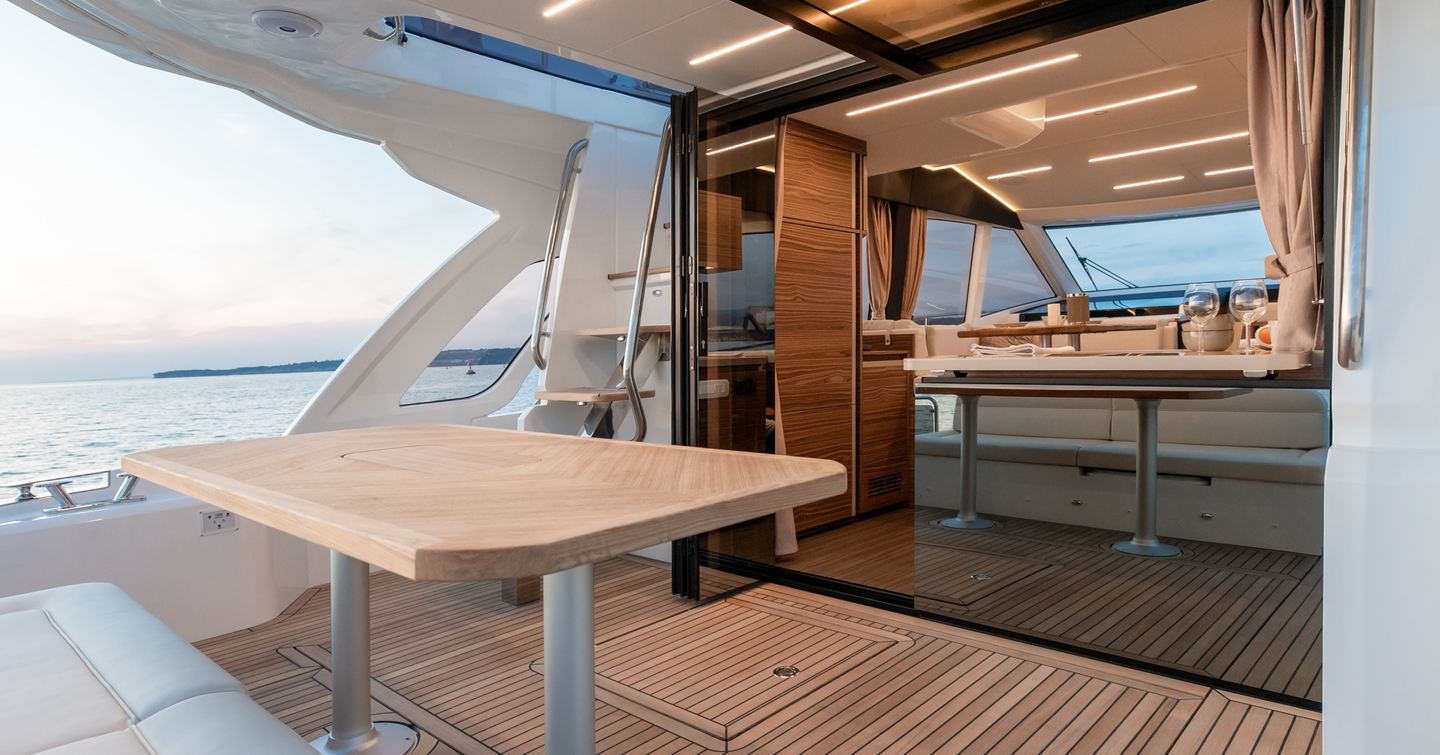


The cockpit isn't enormous and it feels quite basic with its fixed teak table and simple transom bench but it does link to the saloon very easily thanks to the aforementioned door arrangement and pop-out bar section that creates a servery between the two areas. It's an easy boat to move around and the partially covered side decks are safe to negotiate. The boarding gate on the starboard side is a welcome addition and it cleverly slots into a hollow in the gunwale molding so as not to block the passageway when open.
There's a feeling of security up at the bow where there are tall toe rails topped with stainless steel railings that you can steady yourself on. The coachroof features a simple sun pad arrangement, though there are pop-up backrests for a bit of added comfort. Shade up here is provided by a pram hood style canopy, which seems to have gone out of fashion in place of a canvas and poles, but this is a much neater solution that is quicker to put up and down. There are also pop-up lights built into the section below the windscreen, but some storage fiddles and cup holders would be nice to see. The anchor locker is important here because it's one of the few places you can stow the boat's fenders. It could do with having twin hatches but the space itself is good.


Moving On Up
The staircase up to the flybridge is neatly integrated into the cockpit but it is rather steep. That said, there is plenty to hold on to on the way up, including a particularly useful handle on the back of the helm seat. This deck is simple in its arrangement and looks a little basic but the space is good. L-shaped seating curls around the aft end of the deck and centres around another fixed, teak-topped table. The wet bar is conveniently located just forward and features a sink, grill, and fridge, and forward of that, there's a flat double sun pad adjacent to the double helm station.
Our test boat was fitted with the manual bimini but there is a hard top available and that has extra significance aboard the 45 Fly because with it fitted you can fit four more solar panels, giving you a total of six. With the bimini, you only have two mounted forward of the windscreen, and these produce enough power to run the fridge but with the additional four most of the boat's domestic 12V feed can be fed by the power generated from solar panels alone.
It's worth pointing out that the 45 is also available as a coupe, which increases the space for solar panels and has space for a sunroof over the forward section of the saloon. For inland work and for those who like the idea of single-level living, it's an option to consider.
The base price for the 45 Fly with the twin Yanmar 370hp diesels and no hybrid system is €640,000 ex VAT. In the USA, that starting price including import duties and 110V conversion is $880,000 ex VAT (all prices are correct at the time of writing).
Our test boat with the same engines came in at €UR 738,339 ex VAT (correct at the time of writing), which includes the €45,000 High Standards package. This pack adds a decent amount of kit including two 330W solar panels, an automatic inverter, the Marco Casali interior, bow thruster (Sleipner), teak exterior tables, the boarding gate on deck, and the domestic fridge/freezer, amongst other things.
As a base, the 45 Fly offers impressive value for money in this sector but some very pricey options hike the cost up significantly. A prime example would be the hybrid drive system, which is a £160,000 additional cost. There's more to it than silent propulsion, though, because the enormous battery bank (up to 80kW/h) and 20kW generator, which is abnormally powerful for a boat of this size, give you outstanding autonomy and greater energy resilience if you wish to run the boat off grind for longer stints. It's a big chunk of cash but the wider benefits, on top of silent and emission-free slow-speed cruising, need considering.
Our Options & Pick
Would I go for the hybrid option? If the money isn't an issue then it gives the 45 Fly an element that is totally unique in the market and if you do spend a fair amount of time cruising in the low single digits then there are most certainly benefits to be had. It isn't the silver bullet for high-speed, emission-free cruising, however.
The lower deck layout is a personal choice and the standard arrangement with two bathrooms and two ensuites with matching walk-in wardrobes will feel seriously luxurious for a boat of this size if you mainly intend to cruise as a couple with occasional guests. Many will want the added sleeping space of the third cabin, where I think the bunk beds make the most sense. They, like the version with a small double bed in this cabin as on our test boat, are a €5,000 option.
The single MFDs on each helm are part of a €21,000 electronics pack but I think it's worth having twin MFDs in at least one of the helms, most probably the lower one. For longer passages in bad weather or at night, when navigation aids are more likely to come into play, the added screen will be a benefit.
The flybridge wet bar is a €6,300 option that allows the top deck to function so much more effectively as a living space, it's well worth having. Ungainly hard tops aren't always the best option on flybridges but in this instance, it provides fixed shade over the top deck but also acts as a platform to mount more solar panels and is well worth the additional cost.
Our Verdict
There's a lot to like about the 45 Fly. Yes, the steering is hard work, it's not particularly engaging to drive and both helm stations could do with tweaks but, as a whole, the boat works really well and offers a compelling cruising package. The hybrid system will be prohibitively expensive for some, but the benefits reach beyond silent cruising and make the 45 a front-runner if you like to cruise off-grid for long periods and want to stay away from marinas. Crucially, the boat is underpinned by solid, practical design, punchy diesel engines and a smooth-riding hull so if you just want a handsome and spacious 45ft cruiser with a pair of diesel engines it delivers. The hybrid system offers a point of difference in the market but the 45 Fly doesn't need it in order to shine.
Reasons to Buy
- Versatile drive options
- Handsome design
- Flexible lower deck layout
- Value for money
- Practical detailing
Things to Consider
- Hybrid version is expensive
- Lifeless handling
- Helm station design
Looking to own a Greenline 45 Fly? Use YachtBuyer’s Market Watch to compare all new and used Greenline 45 Fly Boats for sale worldwide. You can also order a new Greenline 45 Fly, customized to your exact specifications, with options for engine choice and layout configuration. Alternatively, explore our global listings of new and used boats for sale and find your perfect boat today!
Rivals to Consider
There's nothing truly like-for-like compared with the 45 Fly in this sector but there are some attractive options from a cluster of well-established shipyards.
The Prestige 460 also offers two and three-cabin layouts and a similar look and feel on board. Its interior is also the work of an Italian, Camillo Garoni in this instance, and it's been reworked compared to the Prestige 450 on which this model is based. That boat had separate access to the owner's cabin from the saloon but that's gone on the 460, which favours a more traditional forward companionway. The standard two-cabin variant has a full-beam owner's cabin amidships and a VIP forward, both with their own bathrooms. The three-cabin version replaces the amidships cabin with a twin and smaller double with the master located forward. In either guise, the forward cabin can have scissor berths to add some flexibility. The 460, which also comes as a coupe, is Volvo Penta IPS only (500 or 600) and will top out at around 25 knots.
The Princess F45 is the smallest flybridge boat in the Princess range but it's a seriously classy customer. It may be small but on board, it looks and feels just as high quality as its siblings at the larger end of the F Class range. It's more money than the Greenline but it feels like a premium product through and through. The only layout option is two cabins and two bathrooms but they are beautifully appointed, though standing headroom is limited in the amidships cabin. It's one of only two boats in the Princess flybridge range that run on IPS; IPS600 in this case for a healthy top speed of 31 knots.
The Galeon 440 Fly is the one to go for if deck space is your priority. The drop-down terraces, now inset with glass, create an unbeatable cockpit in this sector and the indoor/outdoor living environment is second to none. It's a high-quality machine, too, with smooth mouldings, chunky stainless fittings and a solid, expensive-feeling interior. It's one of the few boats in the sector to offer shaft drives or IPS, too, D6 480s on shafts or IPS600 with 440hp per side if you opt for pods. Below deck, it's available with a two-cabin and two-bathroom layout or you can add a bunk bed third cabin on the port side.
The Beneteau Swift Trawler 48 is a different proposition to the Greenline but it shares a focus on usability and practical detailing. Its semi-displacement hull is suited to the slower pace of life where at 6 knots it will cover 1,500nm. The twin 425hp Cummins diesels will also push it to a top speed of 25 knots and cruise 340nm at 20 knots. It's a versatile cruising machine that is packed with storage space and very safe and easy to crew as a couple or single-handed. The finish is a little more basic than others on this list but the living space is excellent and includes three cabins on the lower deck, with an owner's ensuite in the bow. It's an excellent cruising companion and a brilliant all-around package for the money.
Considering a new boat? Explore Greenline's entire current range to find the model that best suits your needs, and compare it with alternatives from competitors to ensure you make the perfect choice.
Specifications & Performance
- Builder Greenline
- Range Greenline
- Model Greenline 45 Fly
- Length Overall 51.083ft
- Beam 14.665ft
- Hull GRP
- Cabins 3
- Berths 8
- Crew 1
- Cruising Speed
- Max Speed
- Fuel Capacity 396 Gallons
- Fresh Water Capacity 174 Gallons
- Engine Model 2x Yanmar 8LV370
- Engine HP 370
- Engine economic speed 8.4 knots
- Engine max range (speed type) 612.8 (nm)
Performance Data
Greenline 45 Fly version 2019. *Data supplied by the manufacturer.
Test Engines Twin Yanmar 8LV370
- RPM
- Knots
- Liters Per Hour
- Liters Per Mile
- Range (nm)
- Decibels
-
- 1,000
- 5.7
- 3
- 1
- 1,509
- -
-
- ECO
- 1,400
- 7.3
- 12
- 2
- 842
- -
-
- 1,800
- 9.0
- 23
- 3
- 526
- -
-
- 2,200
- 10.3
- 44
- 4
- 316
- -
-
- 2,600
- 13.0
- 64
- 5
- 273
- -
-
- 3,000
- 17.5
- 89
- 5
- 264
- -
-
- CRUISE
- 3,400
- 21.0
- 116
- 6
- 244
- -
-
- MAX
- 3,800
- 24.5
- 148
- 6
- 224
- -
Yacht Load: 0 Litres of water 25 Litres of fuel 7 members of crew air temperature of 15 °C
Notes: Range figures account for 10% fuel in reserve
Available Stock
Interested in a Greenline 45 Fly?
NEW Build
Find your local dealer for a personalised, no-cost consultation
or just request
Brochures & Pricing
Used & In Stock
Looking for a ready-to-go Greenline 45 Fly or pre-owned options? Explore all inventory of the Greenline 45 Fly available worldwide
